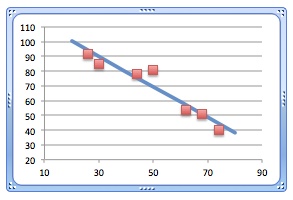Examples — Computing with RPN-45
|
1 - Pearson correlation coefficient and regression line
|
 |
|
2 - Sample and true ("population") standard deviation |
|
3 - Lottery 1 ENTER 39 ENTER Tap RAN# repeatedly to get your random numbers, skipping any duplicates.
|
|
4 - Odd root of a negative integer Interestingly, most calculators can't handle this, producing an error message instead. Or a complex number. |
|
5 - Cubic equation shows the real root x1 = 2.000. Verifying x2 (assuming the real part 1.000 is still in X, the imaginary part 1.732i in Y): |
|
6 - Linear equation in two unknowns x + y = 62 Putting all unknowns to the left side of the equal signs, we get: 1*x + 1*y = 62 The coefficients map to the storage registers as follows:
Store the coefficients and execute the calculation: 1 STO 4 1 STO 5 62 STO 6 We get x = 46 (father) and y = 16 (son). |
|
7 - Euler's identity |
|
8 - Cube root of a complex number For natural numbers n, the nth root of a complex number has n solutions. The method shown above only produces the principal solution. |
|
9 - Complex numbers in polar form |
|
10 - Calculating with complex numbers
|
|
11 - The "DATE" Function
|
|
12 - Calendar Reform Input: -2.091752 DATE 1 DATE results in Thursday, 14 September 1752 In Russia the October Revolution was in fact a November Revolution: |
|
13 - Extended Σ+ Functions Example: Find half of the sum of the vectors (6,7) and (8,11). |
|
14 - Weighted Mean
What's the average gas price? Clear the statistics registers with CLEAR. Enter the values shown above (for each pair: y ENTER x, then Σ+). |
|
15 - Remarkable Formulas Make sure the calculator is set to angular mode DEG and activate mode CMPLX. 4 ENTER 3 √x x 4 I 3 1/x yx →∠ (read the imaginary part of the result as 10°) 2 - Benjamin Peirce, an American mathematician (1809 bis 1880), called the following relation "a mysterious formula": Activate CMPLX mode, then compute Pi minus the right side of the equation: π 2 ENTER 1 Re↔Im ÷ LastX ln x – (the result is 0, as expected) |


